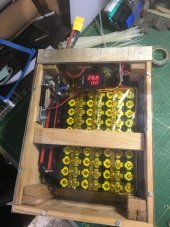Hey
So I just finished setting up this li-ion battery from repurposed cells.
It's my first one of some scale (7S10P 29.4V 33AmpH), and it seems to work well.
Now for the first time I hooked it up to my solar panels.
They are each 50w, so I put them in series to give 24v.
It looks as if everything worked well (as of now I only tried them in dim indoor light).
My question has to do with the connecting of the cables.
I remember from a video on youtube from Will Prowse that you should give a spark to one of the terminals before connecting them. In my case however I got XT90s and XT60s, so there's no chance for that in my set-up.
When I connected them now indoors (solar panels facing down) there was a small spark at the connectors from charge port of the solar charger to the battery. Afterwards I turned the solar panels facing upwards, and when I connected the inverter to the discharge/output port-- again a spark. I couldn't see it, I only heard it. It left a small burn mark on the connecter. It seems insignificant -- do damage. Just a mark. But I was wondering if I am doing something wrong here. Any tips?


Cheers
So I just finished setting up this li-ion battery from repurposed cells.
It's my first one of some scale (7S10P 29.4V 33AmpH), and it seems to work well.
Now for the first time I hooked it up to my solar panels.
They are each 50w, so I put them in series to give 24v.
It looks as if everything worked well (as of now I only tried them in dim indoor light).
My question has to do with the connecting of the cables.
I remember from a video on youtube from Will Prowse that you should give a spark to one of the terminals before connecting them. In my case however I got XT90s and XT60s, so there's no chance for that in my set-up.
When I connected them now indoors (solar panels facing down) there was a small spark at the connectors from charge port of the solar charger to the battery. Afterwards I turned the solar panels facing upwards, and when I connected the inverter to the discharge/output port-- again a spark. I couldn't see it, I only heard it. It left a small burn mark on the connecter. It seems insignificant -- do damage. Just a mark. But I was wondering if I am doing something wrong here. Any tips?


Cheers



![20210820_120240[1].jpg 20210820_120240[1].jpg](https://diysolarforum.com/data/attachments/60/60939-c21b056ebe7db4d81280861e6afff207.jpg)